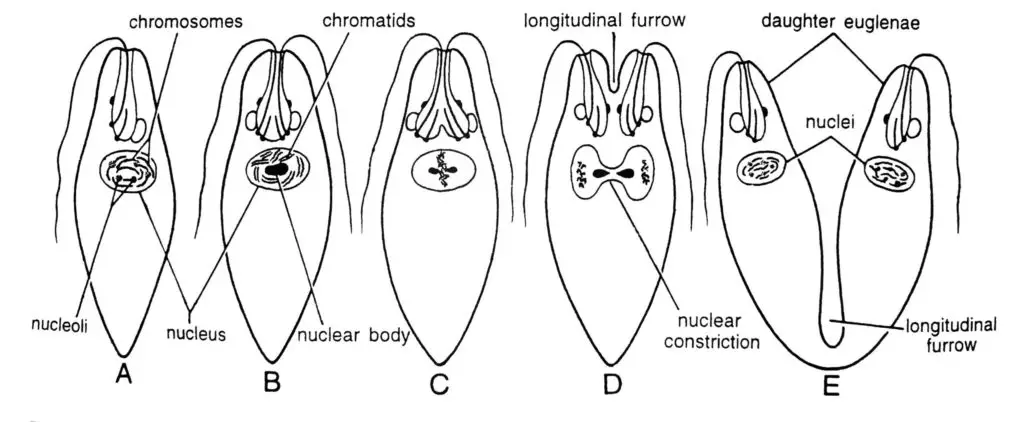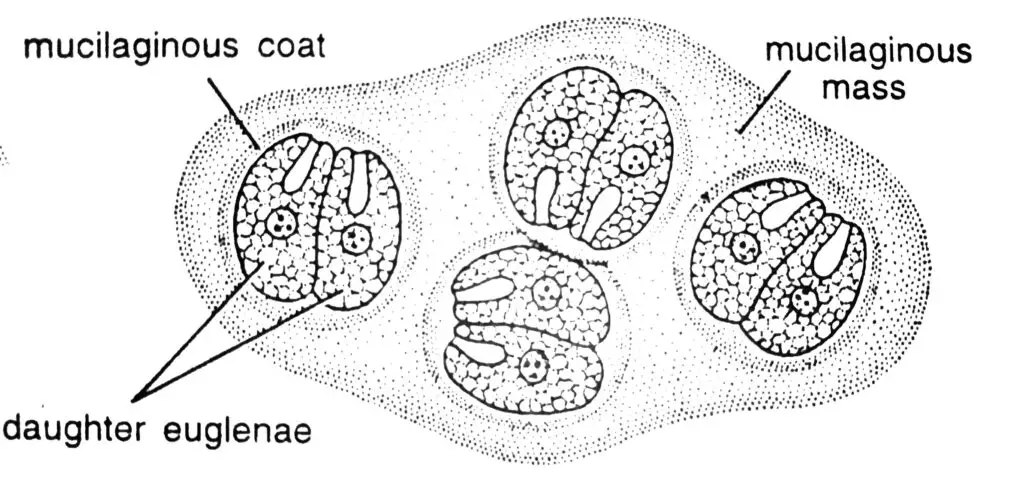How does Euglena reproduce? (Reproduction in Euglena)
Euglena reproduces asexually using the processes of longitudinal binary fission and multiple fission only.
In longitudinal binary fission, Euglena divides mitotically in the axil or longitudinal way to form identical daughter cells in the open water.
In the multiple fission type of reproduction, Euglena shows the stages of encystment where various daughter cells are reproduced longitudinally within the cyst.
Euglena is a type of protozoa included in Kingdom Protista. It finds its application both in the plant and the animal kingdom thus, included both in Zoology and Botany.
The most common form of reproduction in the Protozoans is asexual reproduction that is mainly through the process of binary fission. In binary fission, the organism duplicates its cell parts and then divides itself into two separate organisms.
In the case of Euglena, the Longitudinal type of Binary Fission can be seen leading to the reproduction of symmetrical organisms.
Two other forms of asexual reproduction used by protozoans are called budding and schizogony. But here in the case of Euglena, there is no such evidence of sexual reproduction.
So that’s why, while talking about the Reproduction In Euglena, we should always consider asexual binary and multiple fission reproduction techniques only.
How does Euglena reproduce? Reproduction in Euglena is of 2 types:
- Binary Fission: Euglena divides longitudinally into two daughter cells openly in water.
- Multiple Fission: Euglena divides longitudinally into multiple daughter cells inside the cysts.
1. Binary Fission

Stages: A-Interphase, B-Prophase, C-Metaphase, D-Anaphase, E- Telophase & Cytokinesis
Transverse Binary fission when the cell divides transversely is unknown in Euglena.
So, when the favourable conditions of water, temperature, and food availability are met, Euglena divides by simple longitudinal binary fission.
Binary fission is actually an asexual mode of reproduction in which the Euglena divides into two equal halves.
The process starts with the duplication of the genetic contents of a parent cell by the process of replication, followed by karyokinesis, and then cytokinesis.
And when the binary fission takes place along the longitudinal plane (axis) of Euglena’s body, it is known as longitudinal binary fission.
The main noticeable factor of the binary fission in Euglena is the production of two daughter cells from the parent cell in a perfectly symmetrical way.
These newly formed daughter cells are symmetrogenic in nature which means that it is the plane mirror image of the other.
Here, in this type of reproduction first, the nucleus divides into two by mitosis (includes stages: prophase, metaphase, anaphase, and telophase) which is later followed by the division of the cytoplasm.
In this way, the parent cell divides into two identical daughter cells.
The only unusual feature that can be seen during the mitotic nuclear division is the persistence of the nuclear membrane.
2. Multiple Fission

A- Encysted individual, B- Fission in encysted condition, C- Palmella stage
Multiple Fission is usually performed under inactive conditions, that is when the favourable conditions of water, temperature, and food availability are not met.
While Binary fission means the formation of two daughter cells, Multiple fission means the formation of more than two daughter cells i.e. the production of multiple daughter cells.
One parent cell can lead to the formation of multiple daughter cells. These multiple daughter cells can divide longitudinaly one after the other and are symmetrogenic in nature.
Under inactive conditions, Euglena stops its activities like movement from one place to another and protects itself by forming a coat around its body.
The Euglena throws off its locomotory flagellum and becomes rounded and gets embedded in an extensive, thick, and mucilaginous coat covering called cyst. This is also called the Encystment of Euglena.
Then soon after encystment, the Euglena performs repeated longitudinal binary fission with mitosis and cytokinesis leading to the formation of several daughter individuals.
These newly formed daughter individuals remain embedded within the mucilaginous mass of the cyst covering.
Sooner or later, each daughter individuals secretes their own mucilaginous cysts that perfectly resemble the palmella stage of many algae like the Chlamydomonas.
Later, when the favourable conditions of water, temperature, and food availability are met, these daughter individuals acquire their own locomotory flagella and escapes from the cyst to grow into adult Euglenae.
The process of fission to form two daughter cells
The process of fission to form two form daughter cells in both binary and multiple fission processes include Mitosis (Stages: Prophase, Metaphase, Anaphase, and Telophase) and, later Karyokinesis and then Cytokinesis occurs.
The stages are as followed:
1. Prophase Stage: In this stage, all the nucleoli (endosomes) fuse together into a single nuclear body and each chromosome splits longitudinally into two daughter chromosomes or chromatids.
2. Metaphase Stage: In this stage, all the paired chromatids come to lie in a longitudinal plane. The microtubules are present in the nucleus but they do not form any spindle fibres.
3. Anaphase Stage: In this stage, the paired chromosomes separate and move towards their respective poles with mutual repulsion.
4. Telophase Stage: In this stage, the nuclear membrane begins to constrict longitudinally and gets deepened.
5. Karyokinesis: In this stage, the nuclear membrane fully deepens and finally separates the nucleus into two daughter nuclei.
6. Duplication of cell organelles: Organelles such as the reservoir, cytopharynx, cytosome, flagella, stigma, basal bodies, and contractile vacuole duplicates.
7. Cytokinesis: In this stage, a longitudinal wrinkle appears in the cytoplasm of the cell with the two daughter nuclei in it. This eventually deepens and finally divides the cell into two daughter cells with one daughter nuclei and one previously duplicated cell organelles in each cell.
8. Formation of other cell organelles: Cell organelles that weren’t duplicated before cytokinesis now gets newly formed by a variety of mechanisms inside the new daughter cells. For example: Flagellum is formed from the basal bodies.

Encystment during the multiple fission reproduction in Euglena
Encystment means formation of a cyst. It is the process of becoming enclosed by a cyst.
The cyst is an extensive, thick, and mucilaginous coat covering the body of the Euglena.
Encystment usually takes place as a protective measure to save the Euglena when unfavourable conditions of water, temperature, and food availability are not met. This can be due to the lack of food and oxygen, draught, and excessive heat, etc.
First of all, Euglena becomes inactive, loses its flagellum, and secretes a cyst around it under the unfavourable conditions.
The Euglena forms the encystment by producing a cyst-wall which is in the form of a thick, spherical, yellowish-brown, and gelatinous covering, composed of a spherical carbohydrate.
The cyst is secreted by the muciferous bodies lying below the pellicle.
In different species of Euglena, cyst may be thick (composing of 2 to 4 layers), stalked, or operculated with the organism lying centrally or eccentrically in it.
The encysted Euglena not only successfully withstands the adverse conditions of life, but also enjoys a far, and wide dispersal.
Later, when the favourable conditions of water, temperature, and food availability are met, the animal escapes from the cyst and resumes its normal life.
If the Euglena has encysted itself, and then if reproduction occurs that will be termed as multiple fission reproduction. The individual can undergo a single or several divisions, resulting in the formation of two or many new individuals inside the cyst. This is also known as the Palmella Stage in Euglena.
